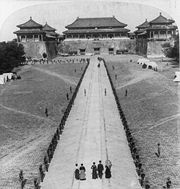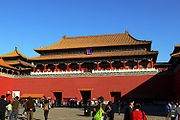
Meridian Gate
Encyclopedia


Forbidden City
The Forbidden City was the Chinese imperial palace from the Ming Dynasty to the end of the Qing Dynasty. It is located in the middle of Beijing, China, and now houses the Palace Museum...
. It has five arches. The three central arches are close together; the two flanking arches are farther apart from the three central arches. The center arch was formerly reserved for the Emperor alone; the exceptions were the Empress, who could enter it once on the day of her wedding, and the top three scholars of the triennial civil service examinations, who left the exams through the central arch. All other officials and servants had to use the four side arches.
Above the arches are a series of buildings. The central one is the palace of nine bays wide, with double roofs. In each side, the 13 bays-wide building, single roof, connects the two pavilions on the top. The Emperor of China
Emperor of China
The Emperor of China refers to any sovereign of Imperial China reigning between the founding of Qin Dynasty of China, united by the King of Qin in 221 BCE, and the fall of Yuan Shikai's Empire of China in 1916. When referred to as the Son of Heaven , a title that predates the Qin unification, the...
reviewed his troops from this location during the Ming
Ming Dynasty
The Ming Dynasty, also Empire of the Great Ming, was the ruling dynasty of China from 1368 to 1644, following the collapse of the Mongol-led Yuan Dynasty. The Ming, "one of the greatest eras of orderly government and social stability in human history", was the last dynasty in China ruled by ethnic...
and Qing
Qing Dynasty
The Qing Dynasty was the last dynasty of China, ruling from 1644 to 1912 with a brief, abortive restoration in 1917. It was preceded by the Ming Dynasty and followed by the Republic of China....
dynasties.
Its superstructure is also called the "Five Phoenix Turrets" because it is composed of five buildings. Imperial proclamations and almanacs were issued from the gate house. After successful campaigns, the Emperor received prisoners of war here, sometimes followed by mass decapitations.
Although urban myth has it that senior officers were executed here in Imperial China; in reality only corporal punishment was actually carried out.
Behind the viewer is Duanmen Gate, the principal entrance to the imperial palace grounds.
When proceeding northward through the palace grounds, the next major gate encountered is the Gate of Supreme Harmony
Gate of Supreme Harmony
The Gate of Supreme Harmony , is the second major gate at the southern side of the Forbidden City.The gate was originally built during the Ming Dynasty, when it was called Fengtianmen . Following the Qing conquest of China, the gate was given its present Chinese and Manchu name.It is flanked by two...
.
In popular culture
In the Nickelodeon animated television show Avatar: The Last AirbenderAvatar: The Last Airbender
Avatar: The Last Airbender is an American animated television series that aired for three seasons on Nickelodeon from 2005 to 2008. The series was created and produced by Michael Dante DiMartino and Bryan Konietzko, who served as executive producers along with Aaron Ehasz...
, in the Earth Kingdom capital city of Ba Sing Se, the main gate to the Imperial Palace is based on the Meridian, almost identical in appearance.

